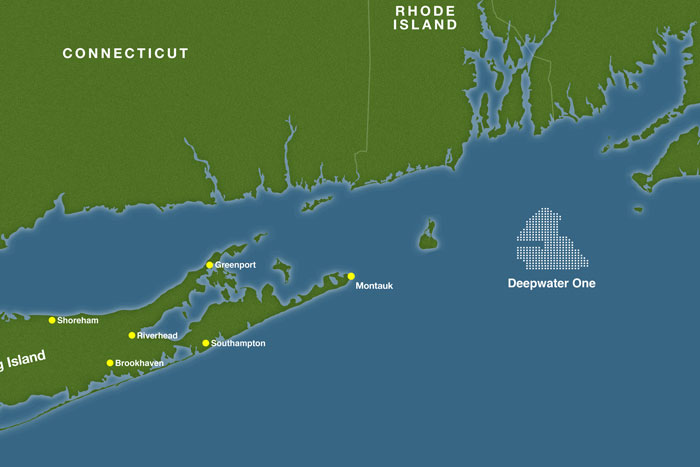90-Megawatt Wind Power Project Proposed Off Montauk

Offshore wind farm developer Deepwater Wind is proposing a 15-turbine project 30 miles east of Montauk to provide renewable energy for the South Fork. The wind farm would fulfill East Hampton Town’s pledge to get 100% of its electricity from renewable sources, and then some, while also moving the Long Island Power Authority (LIPA) closer to its goal of adding 280 megawatts of renewable energy to its grid.
Dubbed Deepwater ONE, the 90-megawatt wind farm could power 50,000 homes, according to Deepwater Wind, which says construction could start as early as 2019, with completion by 2022.
“We hope that LIPA, PSEG and the state of New York take this proposal seriously,” East Hampton Town Supervisor Larry Cantwell says.
Deepwater Wind won a 30-year lease of 256 square miles in the Atlantic Ocean on the Outer Continental Shelf in 2013. The site has the potential for 200 wind turbines—this first phase to serve the South Fork would represent just 7.5% of the capacity. Later phases could serve New England and more of Long Island.
“We think it’s one of the best areas to build offshore wind in the world,” says Clint Plummer, the vice president of development at Deepwater Wind. He points to the area’s proximity to regions that are seeking new sources of energy, while being far enough away from the coast that the turbines will not be visible from land.
The water is also relatively shallow, he notes. The depth is between 90 and 120 feet, while the turbines will stand 600 feet tall from the water’s surface. Comparatively, he says the Gulf of Mexico—where wind farms have also been pitched—is several thousand feet in depth.

Deepwater Wind is responsible for the United States’ first offshore wind farm, the five-turbine Block Island Wind Farm, which is presently under construction and expected to be operational by this time next year. Deepwater ONE will take advantage of the lessons learned from the Block Island Wind Farm, and a larger scale, to deliver electricity at a more competitive rate, Plummer says.
Compared to building new fossil fuel or solar projects on Long Island, Deepwater ONE would provide electricity for approximately the same cost, he adds.
Transmission cables would be buried deep below roads and there would be no new overhead cables or poles required to deliver the energy to the LIPA substation in East Hampton and Deepwater Wind’s proposed battery energy storage facilities in Montauk and Wainscott.
“The details are going to have to be worked out and subject to public participation,” Cantwell says. “The utilities will all be underground, which is a major plus, but the locations of the storage facilities will be subject to a local site planning process and public participation.”
The storage facilities—on Industrial Road in Montauk and at the Wainscott Commercial Center—would use General Electric lithium-ion battery technology. Forecasted to be operational by 2018, the facilities could store 15 megawatts of energy between them.



